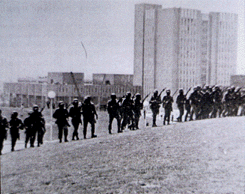Renee Green
Pat Hearn Gallery
Oct.19, - Nov.24,1996
There is enough material in the exhibition to start researching a nonfiction bestseller. Renee Green is the maincharacter. In the background is her personal relationship to Kent State University, Ohio, which unfolds as a story about a nearly forgotten art work, a massacre, Black Power, and life-as-style in the seventies as a jumping point for interviews on these and related issues.
The dramaturgy moves back an forth between early seventies and 1996. If you think that an art exhibition should offer a wide range of material, then you will not want to miss this show. If you think, art is somehow transforming all these documented facts and takes them as sources for personal expression or highly formalized pieces, than you will miss the art work at Pat Hearn Gallery.
But let's talk about colors. Since colors constitute a background for stories and histories, documented in this installation by Renee Green. The different stories have their concerted focus at Kent State University, and are displayed in books, photographs, film, video, records, furniture, gadgets and ... colors. Monochrome wallpainting would be the correct term, because the colors are a bit too precise, to be simple whitewashing. A sandy, washed-out yellow carries a series of color photographs, taken from various sites at Kent State University, during a working visit some months ago. Opposite a green, somehow a bit friendlier than the well known military green, which carries black and white reproductions from the infamous events--which led to deadly shots at Kent State University.

"Four Dead In Ohio," I can remember the lyrics of that song. "Tin soldiers and Nixon are coming. Finally we are on our own." Living at that time in Germany, even there, I felt, the war had come to the United States--Maybe they will change the lyrics for a Wal-Mart version.
An intense light yellow supports three reprints of Afro and Black Power illustrations from the last decades. At least in my youth, I was convinced, that this hair style we used to call "Afro Look" was connected to Black Power. At that time we were drinking "Afri Cola", and one of the famous ads, running on TV, had the line: "1970, Im Afri Cola Rausch." As I said before, if you like these kind of shows with a lot of interfering materials, you will also appreciate these stream of consciousness, that they bring to mind.
As far as I know, there exists two drawings by Robert Smithson tiled: "Partially Buried Woodshed." The woodshed itself, buried with tons of earth, is the only existing earthwork of Robert Smithson in the North-East of the United States. The piece at Kent State University used a rundown, abandoned woodshed, upon which Smithson deposited large amounts of dirt and sediment. Smithson wrote himself: "Everything in the shed is part of the art and should not be removed. The entire work of art is subject to weathering and should be considered part of the work." Some color photographs of the first mentioned series demonstrate the condition of "Partially Buried Woodshed" a few months ago.
Private history, political history and art history have a crossroad at Kent State University. All four elements of this crossroad led to a deadend. But they are only partially buried, they still remind us what all those people were loving and fighting for.

The backroom of the gallery, in warm broken orange, takes me back to future-like interior design of early seventies. A Yearbook from Kent State University, a super-8 film, videos with interviews, a cd-rom, a selection of records, and a setting for the interviews, combines the partially buried non-site objects of the main space with a site-specific working place. Here history comes alive with the thoughts and memories of those still alive today. It doesn't matter if you like the show or not--Renee Green has a precise definition of her vision of history and art as site-context for personal reflection and forgetting.
Rainald Schumacher
Email: ThingReviews
To post a response fill out the following form and click the "Submit" button. Or go back...
Scroll down to read messages.
--
Responds:
--
Responds:
Serge Khripoun -- xlart@redline.ru
Responds:
Rainald, I'm happy to get in touch with The Thing in general - and your reviews particularly - and would be even more happy to join contributing forces back. The forthcoming event here in Moscow (March 3 thru 8) is and International Art Expo. If there's any need in materials from Russia, I'm ready. Serge
--
Responds:
Kim Machan -- kma.aone.net.au
Responds:
Rainald... are you here? I have 2 exceptional tapes to send you ...for the love of art...xxxkim
